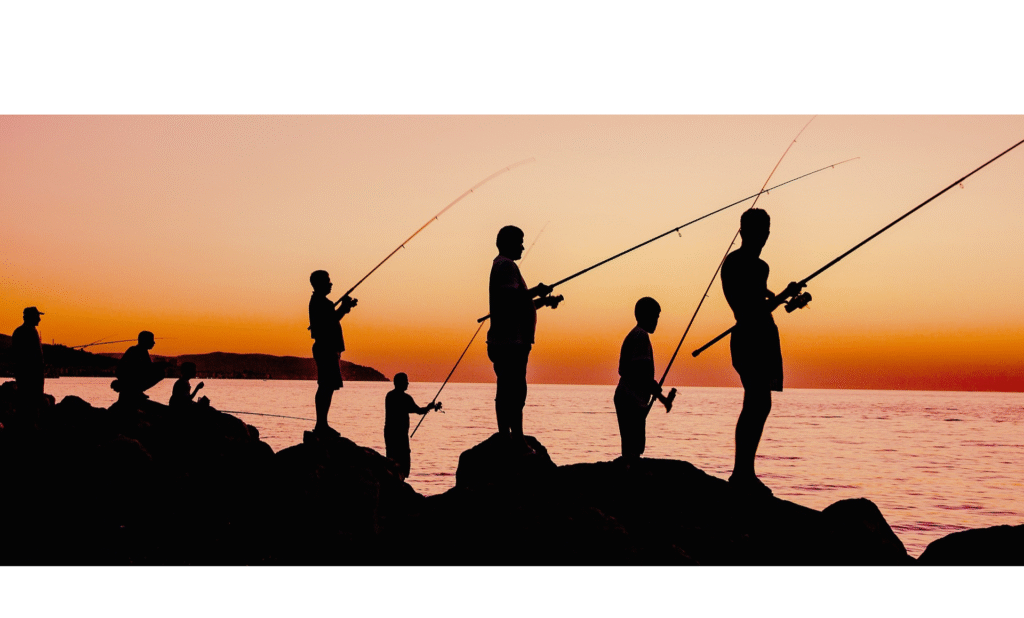Fishing Techniques: Global Perspectives
Fishing methods across the globe have evolved based on local environments, traditions, and needs. Traditional, commercial, modern, regional, and sustainable techniques each showcase unique characteristics. Below is an in-depth look into various fishing techniques:
1. Traditional Fishing Methods
These methods have been used for centuries to sustain livelihoods and collect food. They are often eco-friendly and cost-effective.
Hand Fishing:
- Method: Catching fish or shellfish directly by hand.
- Regions: Coastal areas of Southeast Asia and Africa.
- Features: Suitable for small-scale, shallow water fishing.
Spear Fishing:
- Method: Using a sharp spear or harpoon to catch fish.
- Regions: Pacific Islands, Africa, and the Amazon in South America.
- Features: Effective for catching large fish.
Fish Trapping:
- Method: Bamboo, wooden, or net traps are placed in rivers.
- Regions: Bangladesh, Thailand, and the Congo.
- Features: Low-cost and environmentally friendly.
Cast Net Fishing:
- Method: Throwing a circular net to capture fish in schools.
- Regions: Bangladesh, India, and Latin America.
- Features: Ideal for catching fish in groups.
2. Commercial and Large-Scale Techniques
These methods are designed for capturing fish in bulk, often using modern equipment and large nets.
Trawling:
- Method: Dragging large nets along the seabed or mid-water.
- Regions: Europe, North America, and Asia.
- Features: Capable of catching large volumes of fish.
Drift Netting:
- Method: Floating large nets in currents to capture fish.
- Regions: Asia and North America.
- Features: Effective for catching fish that swim with the current.
Purse Seining:
- Method: Encircling a school of fish with a large net and trapping them.
- Regions: Coastal Europe and Africa.
- Features: Highly efficient for catching large schools of fish.
3. Modern and Technological Techniques
With advancements in technology, fishing techniques have become more precise and efficient.
Electrofishing:
- Method: Using electrical currents to temporarily stun fish.
- Regions: Used in research and conservation projects.
- Features: Effective for specific fish species.
Sonar Technology:
- Method: Using sonar signals to detect fish underwater.
- Regions: Large lakes and seas.
- Features: Quickly identifies fish locations.
Hydraulic Fishing:
- Method: Using water currents to guide fish into nets.
- Regions: Aquaculture projects.
- Features: Safe and sustainable for aquatic harvesting.
4. Regional Fishing Methods
Fishing techniques often vary based on regional practices and traditions.
Asia:
- Trained cormorants are used for fishing in China.
- Bamboo traps and bait fishing in the Ganges, India.
- “Jhaki Jal” and “Dori Jal” nets are common in Bangladesh.
Africa:
- Wooden canoes for fishing in the Congo River.
- Large nets and traps in the Nile.
South America:
- Use of spears and bows in the Amazon.
- Traditional handmade fish traps by indigenous tribes.
Europe:
- Fly fishing in the Danube and Rhine rivers.
- Ice fishing in Scandinavia during winter.
North America:
- Trolling and angling in the Mississippi River.
- Large-scale net fishing in Canada.
5. Recreational Fishing Techniques
Recreational fishing is a popular activity globally, with unique techniques for leisure.
Fly Fishing:
- Using artificial flies to catch fish.
- Especially popular in North America and Europe.
Ice Fishing:
- Drilling a hole in the ice to fish beneath.
- Practiced in Russia, Canada, and Scandinavia.
Catch-and-Release:
- Catching fish and releasing them back into the water.
- Promoted as part of eco-tourism.
6. Sustainable Fishing Practices
Sustainability is crucial to preserving fish populations and ecosystems.
Community-Based Fishing:
Local communities manage fishing resources collectively.
Selective Equipment Use:
Using tools designed to catch specific species while protecting others.
Seasonal Restrictions:
Halting fishing activities during breeding seasons.
Conclusion
Fishing techniques vary widely depending on the environment, culture, and technology. From traditional hand fishing to advanced sonar systems, humans have continually improved their ability to catch fish. However, adopting sustainable fishing practices is essential to ensure the longevity of fish populations and aquatic ecosystems for future generations.



sbuc7t
di0vaq
96y8g4
Trying out Sprunki Incredibox was a fresh twist on music mixing fun. The new beats and visuals really elevate the experience. If you love creativity, check out Sprunki Mods for more unique gameplay.
9pba4a